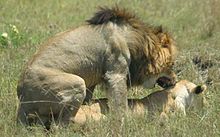
Back Seks Afrikaans Geschlechtsverkehr ALS ወሲባዊ ግንኙነት Amharic Relación sexual AN جماع Arabic سيكس (بيولوجيا) ARY معاشره جنسيه ARZ যৌন সংগম Assamese Rellación sexual AST Cinsi əlaqə Azerbaijani

Sexual intercourse (or simply called sex) is the insertion and thrusting of a male's penis into a female's vagina.[1][2] People and animals that sexually reproduce use sexual intercourse to create offspring. Sometimes sexual intercourse is called coitus, copulation, mating, or fornication, and is more casually known as having sex or sleeping together. The two animals may be of opposite sexes or they may be hermaphroditic, as is the case with snails.[3] Sexual intercourse may also be between individuals of the same sex.
Humans sometimes engage in behaviors that do not include the penetration of sexual organs, such as oral intercourse or anal intercourse or by non-sexual organs (fingering, fisting). These behaviors are sometimes included in the definition of sexual intercourse.[2] Sex is usually teleiophilic (between adults).[4]
Two animals coming together for the purposes of sexual reproduction is called mating. Most mammals only mate when the female is at the point of estrus, which is the most fertile period of time in its reproductive cycle.[5][6] In certain animals, sexual intercourse is not only used for reproduction, but has taken other functions as well. These animals include bonobos,[7] dolphins,[8] and chimpanzees which also have sexual intercourse even when the female is not in estrus, and to engage in sex acts with same-sex partners.[9] In most instances, humans have sex primarily for pleasure.[10] This behavior in the above mentioned animals is also presumed to be for pleasure,[11] which in turn strengthens social bonds.
- ↑ Sexual intercourse Britannica entry.
- ↑ 2.0 2.1 "Sexual Intercourse". Discovery.com. Archived from the original on 2008-08-22. Retrieved 2008-01-12.
- ↑ "Common snail, garden snail". BBC. Archived from the original on 2012-12-23. Retrieved 2010-05-13.
- ↑ Beier, Klaus M., et al. "Hebephilia as a sexual disorder." Fortschritte der Neurologie-Psychiatrie 83.2 (2015): e1-e9.
- ↑ "Females of almost all species except man will mate only during their fertile period, which is known as estrus, or heat..." Helena Curtis (1975). Biology. Worth Publishers. pp. 1065. ISBN 0879010401.
- ↑ Pineda, Leslie Ernest McDonald (2003). McDonald's Veterinary Endocrinology and Reproduction. Blackwell Publishing. p. 597. ISBN 0813811066.
- ↑ Frans de Waal, "Bonobo Sex and Society", Scientific American (March 1995): 82-86.
- ↑ Dinitia Smith, "Central Park Zoo's gay penguins ignite debate", San Francisco Chronicle (February 7, 2004). Article is mainly about gay penguins but also mentions homosexuality in dolphins, and also says 'In bonobos, she noted: "you see expressions of sex outside the period when females are fertile."' Available online at http://www.sfgate.com/cgi-bin/article.cgi?f=/c/a/2004/02/07/MNG3N4RAV41.DTL.
- ↑ Bruce Bagemihl 1999. Biological exuberance: animal homosexuality and natural diversity St. Martin's Press, London. ISBN 0-312-19239-8
- ↑ Jared Diamond (1992). The rise and fall of the third chimpanzee. Vintage. ISBN 978-0099913801.
- ↑ John, Gartner (2006-08-15). "Animals Just Want to Have Fun". Wired. Retrieved 2007-10-15.